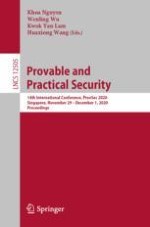2020 | OriginalPaper | Buchkapitel
Watermarkable Signature with Computational Function Preserving
verfasst von : Kyohei Sudo, Masayuki Tezuka, Keisuke Hara, Yusuke Yoshida, Keisuke Tanaka
Erschienen in: Provable and Practical Security
Aktivieren Sie unsere intelligente Suche, um passende Fachinhalte oder Patente zu finden.
Wählen Sie Textabschnitte aus um mit Künstlicher Intelligenz passenden Patente zu finden. powered by
Markieren Sie Textabschnitte, um KI-gestützt weitere passende Inhalte zu finden. powered by
